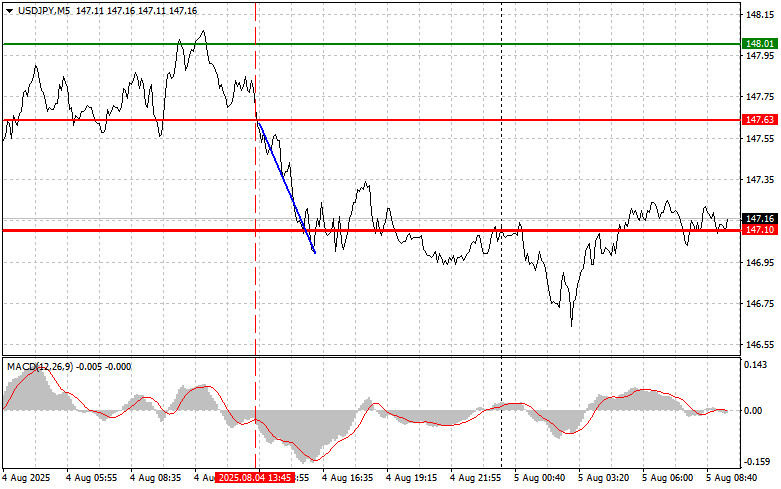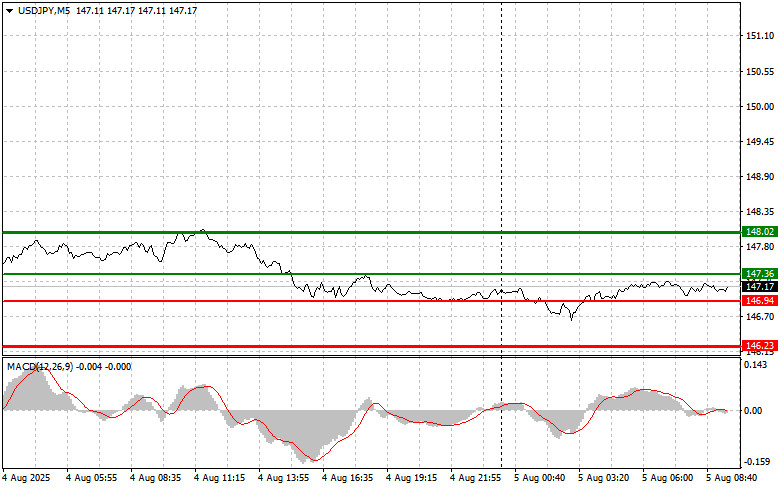Analysis of Trades and Trading Tips for the Japanese Yen
The price test at 147.63 occurred when the MACD indicator had just begun to move downward from the zero level, confirming a valid entry point for selling the dollar and resulting in a drop of over 50 pips in the pair.
Weak data on manufacturing orders in the U.S. put pressure on the dollar, which has already been underwhelming recently due to expectations of interest rate cuts by the Federal Reserve. The Japanese yen has benefited from this situation. Digging into the details, the stagnation in the U.S. manufacturing sector is not just a statistical anomaly but reflects a broader trend of slowing global economic growth. Investors, observing this picture, are shifting toward safe-haven assets, with the yen traditionally being one of them. An additional factor is the Bank of Japan's policy, which, while still accommodative, no longer unambiguously supports ultra-low interest rates as it once did.
Today's strong data on Japan's services PMI further supported the yen's rise against the U.S. dollar. This contrasts with recent weaknesses in the U.S. manufacturing sector, prompting a reevaluation of currency pairs and capital reallocation toward more stable and promising assets. Several factors drive the yen's appreciation. First, the Japanese economy is showing signs of recovery, boosting investor confidence. Second, while the prospects for a shift in the Bank of Japan's monetary policy remain uncertain, they are already supporting the national currency. Thus, the current situation in the currency market reflects not only domestic factors affecting the Japanese and U.S. economies but also a broader global outlook of risks and opportunities. The yen is likely to maintain its position until the outlook for global economic growth and monetary policy among major central banks becomes clearer.
For intraday strategy, I will focus primarily on Scenarios #1 and #2.
Buy Scenario
Scenario #1: I plan to buy USD/JPY today upon reaching the entry point around 147.36 (green line on the chart), with a target to rise toward 148.02 (thicker green line on the chart). Around 148.02, I plan to exit long positions and open short ones in the opposite direction (expecting a 30–35 pip pullback). It's best to return to buying the pair during corrections or significant USD/JPY pullbacks.
Important! Before buying, ensure the MACD indicator is above the zero mark and is just starting to rise from it.
Scenario #2: I also plan to buy USD/JPY today if there are two consecutive tests of the 146.94 level while the MACD indicator is in the oversold zone. This would limit the pair's downside potential and lead to an upward reversal. A rise toward the opposite levels of 147.36 and 148.02 can then be expected.
Sell Scenario
Scenario #1: I plan to sell USD/JPY today only after the price breaks below 146.94 (red line on the chart), which should lead to a sharp decline in the pair. The key target for sellers will be 146.23, where I plan to exit shorts and immediately open long positions in the opposite direction (expecting a 20–25 pip rebound). Strong pressure on the pair is likely to persist today.
Important! Before selling, ensure the MACD indicator is below the zero mark and is just starting to decline from it.
Scenario #2: I also plan to sell USD/JPY today if there are two consecutive tests of the 147.36 level while the MACD indicator is in the overbought zone. This would limit the pair's upward potential and lead to a reversal downward. A decline toward the opposite levels of 146.94 and 146.23 can then be expected.
What's on the Chart:
- The thin green line represents the entry price where the trading instrument can be bought.
- The thick green line indicates the expected price level where a Take Profit order can be placed, or profits can be manually secured, as further price growth above this level is unlikely.
- The thin red line represents the entry price where the trading instrument can be sold.
- The thick red line indicates the expected price level where a Take Profit order can be placed, or profits can be manually secured, as further price decline below this level is unlikely.
- The MACD indicator should be used to assess overbought and oversold zones when entering the market.
Important Notes:
- Beginner Forex traders should exercise extreme caution when making market entry decisions. It is advisable to stay out of the market before the release of important fundamental reports to avoid exposure to sharp price fluctuations. If you choose to trade during news releases, always use stop-loss orders to minimize potential losses. Trading without stop-loss orders can quickly wipe out your entire deposit, especially if you neglect money management principles and trade with high volumes.
- Remember, successful trading requires a well-defined trading plan, similar to the one outlined above. Making impulsive trading decisions based on the current market situation is a losing strategy for intraday traders.














